Book contents
- Frontmatter
- Contents
- Contributors
- Preface
- Part I Reaction-Diffusion Systems and Models of Catalysis
- Part II Kinetic Ising Models
- Part III Ordering, Coagulation, Phase Separation
- Part IV Random Adsorption and Relaxation Processes
- Part V Fluctuations in Particle and Surface Systems
- Part VI Diffusion and Transport in One Dimension
- Part VII Experimental Results
- 20 Diffusion-limited exciton kinetics in one-dimensional systems
- 21 Experimental investigations of molecular and excitonic elementary reaction kinetics in one-dimensional systems
- 22 Luminescence quenching as a probe of particle distribution
- Index
- Abbreviations
20 - Diffusion-limited exciton kinetics in one-dimensional systems
Published online by Cambridge University Press: 18 December 2009
- Frontmatter
- Contents
- Contributors
- Preface
- Part I Reaction-Diffusion Systems and Models of Catalysis
- Part II Kinetic Ising Models
- Part III Ordering, Coagulation, Phase Separation
- Part IV Random Adsorption and Relaxation Processes
- Part V Fluctuations in Particle and Surface Systems
- Part VI Diffusion and Transport in One Dimension
- Part VII Experimental Results
- 20 Diffusion-limited exciton kinetics in one-dimensional systems
- 21 Experimental investigations of molecular and excitonic elementary reaction kinetics in one-dimensional systems
- 22 Luminescence quenching as a probe of particle distribution
- Index
- Abbreviations
Summary
The experimental verification of models for one-dimensional (1D) reaction kinetics requires well-defined systems obeying pure 1D behavior. There is a number of such systems that can be interpreted in terms of 1D reaction kinetics. Many of them are based on the diffusive or coherent motion of excitons along well-defined chains or channels in the material. In this chapter they will be briefly reviewed.
We also present results of an experimental study on the reaction kinetics of a 1D diffusion-reaction system, on a picosecond-to-millisecond time scale. Tetramethylammonium manganese trichloride (TMMC) is a perfect model system for the study of this problem. The time-resolved luminescence of TMMC has been measured over nine decades in time. The nonexponential shape of the luminescence decay curves depends strongly on the exciting laser's power. This is shown to result from a fusion reaction (A+A → A) between photogenerated excitons, which for initial exciton densities ≲ 2xl0-4 as a fraction of the number of sites is very well described by the diffusionlimited single-species fusion model. At higher initial exciton densities the diffusion process, and thus the reaction rate, is significantly influenced by the heat produced in the fusion reaction. This is supported by Monte Carlo simulations.
Introduction
Reactions between (quasi-)particles in low-dimensional systems is an important topic in such diverse fields as heterogeneous catalysis, solid state physics, and biochemistry.
- Type
- Chapter
- Information
- Nonequilibrium Statistical Mechanics in One Dimension , pp. 391 - 420Publisher: Cambridge University PressPrint publication year: 1997



